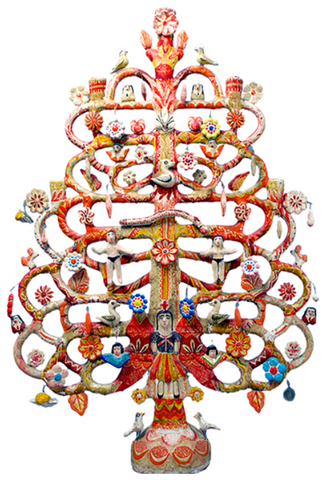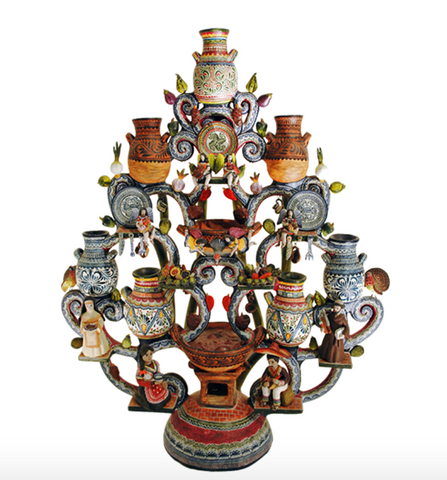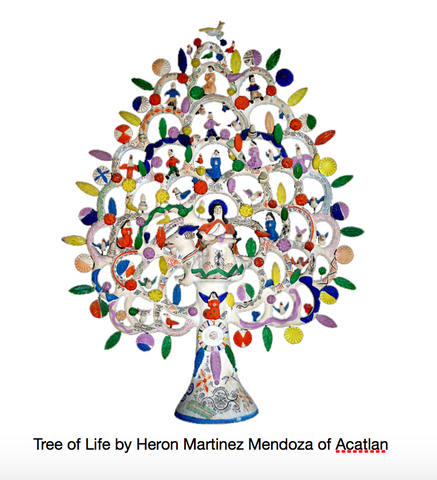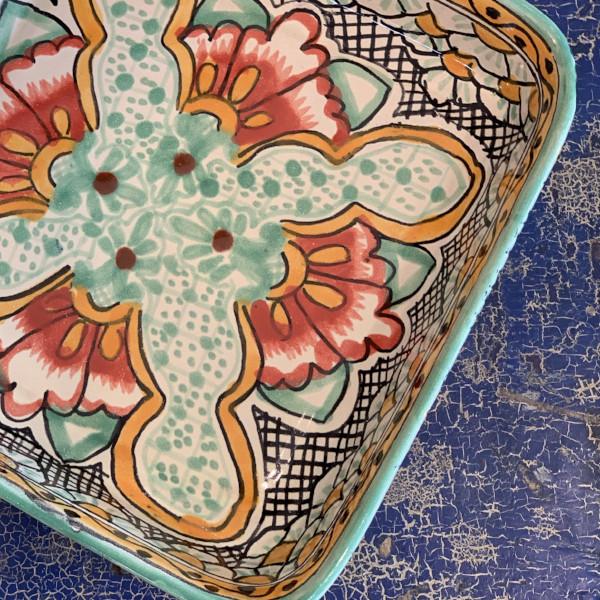This blog post was copied with kind permission from Dyana Garza Levin of the Copal Store in San Jose del Cabo. I thank her for compiling information in a way that is easy to understand and comprehensive! I’ve taken the liberty of editing it very slightly and adding a few links but the structure and important points are Dyana’s.
“A Mexican Tree of Life is a hand coiled pottery sculpture depicting the biblical Tree of Life; traditionally the tree sculpture would include Adam and Eve with the tempting Serpent, but the themes have evolved over time and today it is common to find Trees of Life conveying subject matter such as Day of the Dead and the Folk Art of Mexico.
It’s thought that the decorative clay pieces known as Arboles de la Vida developed from the ceremonial candelabra and incense burners made by craftspeople from Izucar de Matamoros in the the state of Puebla. The design was probably taken from the bronze and silver pieces brought by the Spanish friars, during the conquest, to use in the church. As time went by the clay replicas became colorful and intricately decorated pieces with flowers, leaves and animals on their branches. Adam, Eve and the Serpent usually appear on the main trunk and the Archangel Gabriel appears at the base.

Tree of Life by Aurelio Flores, Izucar de Matamoros
The first potter to start making the more intricate candelabra and incense burners was Aurelio Flores, who began making them in the 1920’s. In addition to their use in the church, the clay candelabra were given to newlyweds to ensure a “good harvest,” referring not only to fertility but to their livelihood in the farming community of Izucar. This custom is no longer as common as it once was.
No one knows who and when named these pieces Arboles de la Vida; the oldest mention of the name related to an Izucar clay sculpture dates from a 1952 book about Mexican folk art written by Patricia Fent Ross. By the 1970’s similar clay sculptures from Acatlán de Osorio, Puebla and Metepec, in the state of Mexico, were being called the same name. As the demand increased, artists in the different towns developed new themes and the sculptures were used to recount religious stories, historic moments and Mexican culture. Some of these new themes included Day of the Dead, Nativity scenes, Mexican crafts and Mata Ortiz pottery.
Trees of Life from Izucar de Matamoros
The trees of life from Izucar are always designed in the same way of candelabra or incense burners; they are painted with multiple colors and are decorated with colored lines. The trees come in different sizes and are about a variety of themes such as The Conquest, The Creation, Regional Costumes and other similar ideas.
For many years, Aurelio Flores was the only person in town making Arboles de la Vida and his son, Francisco Flores (now deceased), learned and continued his style. Their style is considered the most traditional in town.
In the 1960’s the Castillo Orta family developed a new style based on the decoration of the clay with fine lines that almost look like filagree and and introduced many new themes. Alfonso Castillo Orta (now deceased), the youngest sibling gave the multicolored clay from Izucar international fame and acclaim.
 Talavera Pottery Tree of Life by Alfonso Castillo Orta
Talavera Pottery Tree of Life by Alfonso Castillo Orta
Trees of Life from Acatlán de Osorio, Puebla
The Trees of Life from Acatlán de Osorio were first made by Heron Martinez Mendoza (1918-1990). He began making sculptures similar to those from Izucar but with an animal or mermaid as their base. As his work evolved he created burnished or matte-finished trees of life that were decorated with brightly colored leaves and flowers. He is known to have several different periods of work, including the “white period” and an example of this style is below. His themes included Nativity scenes, circus figures, the Virgin of Guadalupe, Adam and Eve and all kinds of whimsical animal figures. Some of the more elaborate pieces were decorated on both sides.
Heron’s style greatly influenced Acatlán’s pottery and today beautiful burnished trees of life are still made in the community. A noteworthy potter from the Acatlán school is Pedro Martinez Lopez.
If you are interested in more information about Heron Martinez Mendoza, there is a website devoted to his amazing and influential work. I also have my own Heron Martinez piece that I acquired serendipitously through Craigslist!

For our current collection of Trees of Life check here.

